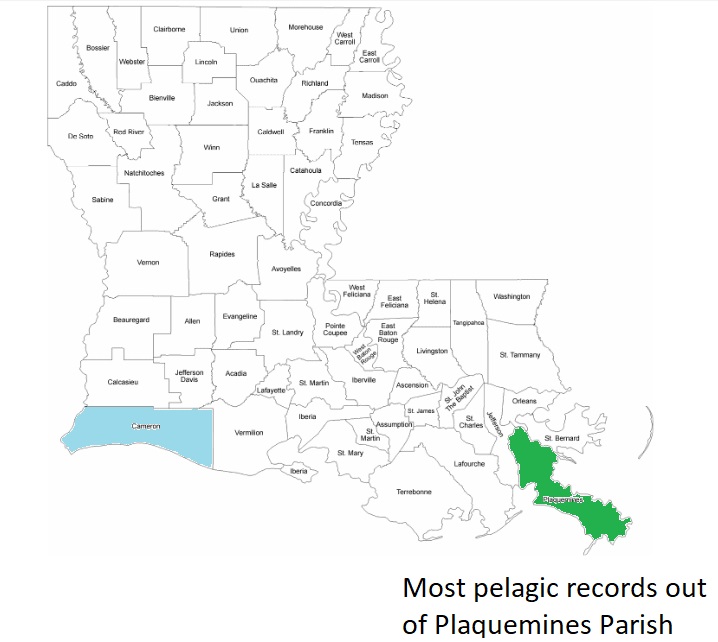
Number of accepted Great Shearwater records for Louisiana = 15


One (85-17/1985-17) on 25 Aug 1985, Gulf of Mexico: 28o 01' N, 91 o 01' W [off Terrebonne]; B. Mac Myers III. This record was accepted by the LBRC, but was inadvertently never published in any report of the LBRC. At the time of its acceptance, it represented the first state record (five previous records [Lowery 1974] were considered unacceptable [Schulenberg 1985]). Because this record is not supported by “hard evidence” it cannot represent the official first state record and becomes an “acceptable sight record.” Record No. 00-10 (above), which is supported by photographs, becomes the official first state record.
One (1998-074) on 13 October 1998, Gulf of Mexico: approximately 44 mi. S of South Pass of
the Mississippi River, N 28.3565o, W 89.13433o; Steven W. Cardiff, Donna L. Dittmann (sketch only), David P. Muth, and Paul M. Dickson; NAB 53(1): 62. This becomes one of two accepted sight
reports pre-dating the official first Louisiana hard-evidence record in 1999.
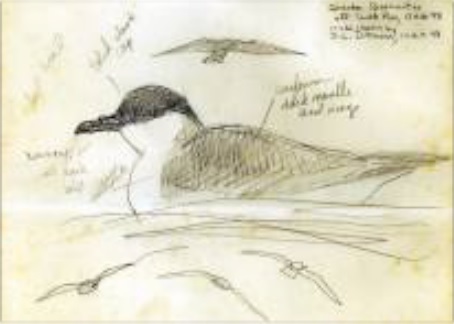
Sketch by Donna L. Dittmann
One (1999-92) on 25 Sep 1999, Gulf of Mexico: 122 mi. S of Morgan City, Green Canyon 18A oil platform, 27o56'37"N, 91o01'45"W; Marshall J. Iliff; NAB54(1):61. This represents an accepted sight record predating the first state record with hard evidence (2000-10); therefore, it is considered hypothetical.
One (00-10/2000-10) on 16 Mar 2000, Gulf of Mexico: South Pass 89B oil platform, 45 mi. SSE of Grand Isle, 28o 40’ 11.2” N, 89o 23’ 36.7” W; Karl Bardon (ph); NAB 54(3): 291. The species was on the official state list on the basis of an acceptable sight record (85-17) that pre-dated adoption of the LBRC’s “hard evidence” policy; record No. 00-10 becomes the official first state record supported by hard evidence, and record No. 85-17 becomes an “acceptable sight record."
Five (2015-050) on 21 September 2015, Gulf of Mexico: ca 31 mi., 34 mi., and 50. mi. SE of Southwest Pass
Mississippi River , N28.566389o, W89.113333o (three with Bridled Terns), N28.393889o, W88.876944o (one with
Leach’s Storm-Petrel), and N28.560833o, W89.063611o (one);
David P. Muth (ph)
and
Dan O’Malley (ph).
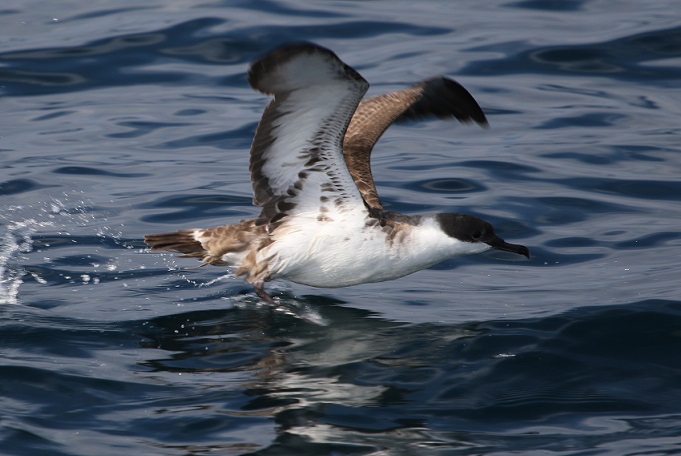
Photo by Dan O'Malley
One (2016-028) on 10 September 2016, Gulf of Mexico: approximately 17 mi. SE South Pass
Mississippi River, N28.841º, W88.962º;
Robert C. Dobbs (ph) and
Oscar Johnson (ph).
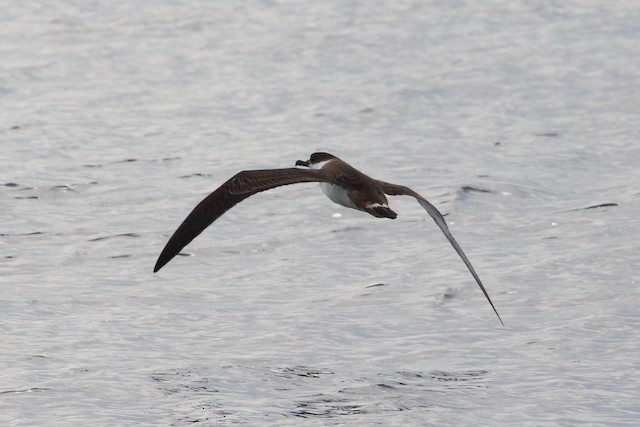
Photo by Oscar Johnson
Three (2016-029) on 10 September 2016, Gulf of Mexico: approximately 22 mi. SE South Pass
Mississippi River, N28.73º, W88.88º;
Robert C. Dobbs (ph) and
Oscar Johnson (ph).
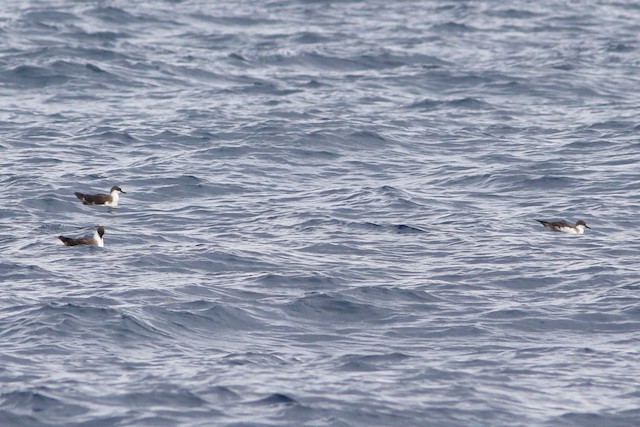
Photo by Oscar Johnson
One (2016-057) on 10 September 2016, Gulf of Mexico: approximately 16 mi. SE South Pass
Mississippi River, N28.79 º, W88.07 º;
Oscar Johnson (ph).
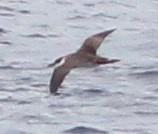
Photo by Oscar Johnson
One in juvenal plumage (2018-094) on 15 September 2018, Gulf of Mexico: Mississippi Canyon at
Continental Shelf break, N28.6309o, W89.1627o); Devin Bosler and Justin Bosler (ph only).
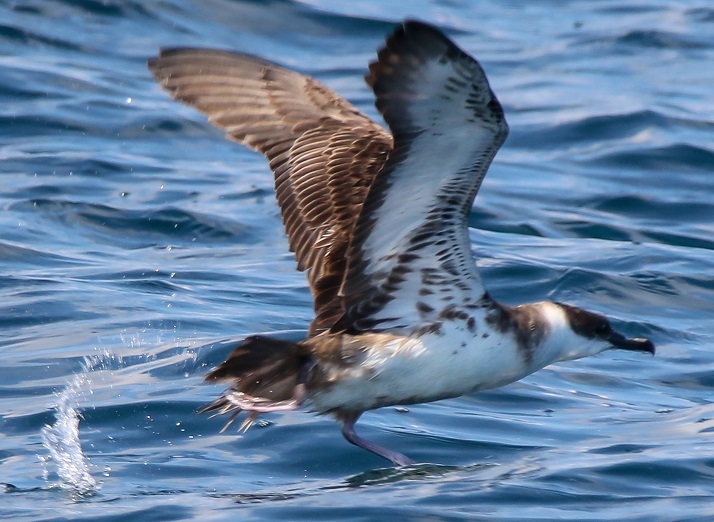
Photo by Justin Bosler
One (2018-060) on 22 September 2018, Gulf of Mexico: 10.7 mi. SE mouth of Southwest Pass of
Mississippi River, N28.798 o, W89.299 o;
Erik I. Johnson (ph),
Paul E. Conover (ph), and
Cameron L. Rutt
(ph only)
.
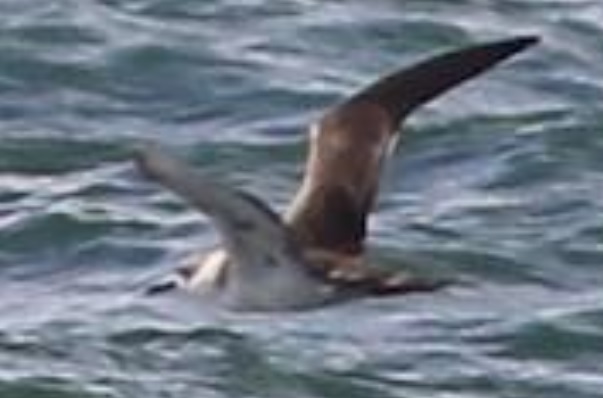
Photo by Cameron L. Rutt
One (2023-046) on 9 September 2023, Gulf of Mexico: 28'14.622, 88'57.225; Paul E. Conover (ph) and David P. Muth (ph).
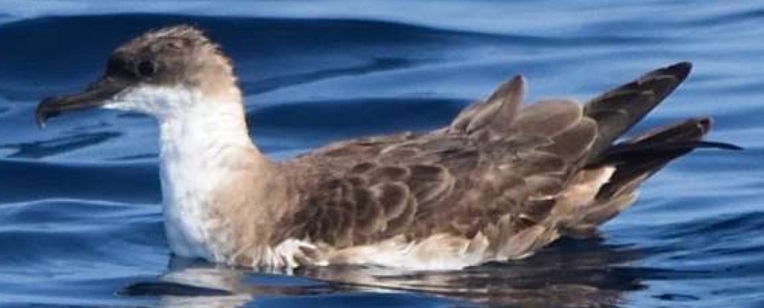
Photo by Paul E. Conover
Two (2023-047) on 9 September 2023, Gulf of Mexico: Leg began at 28.2437639 -88.9519674; Paul E. Conover (ph) and David P. Muth (ph).
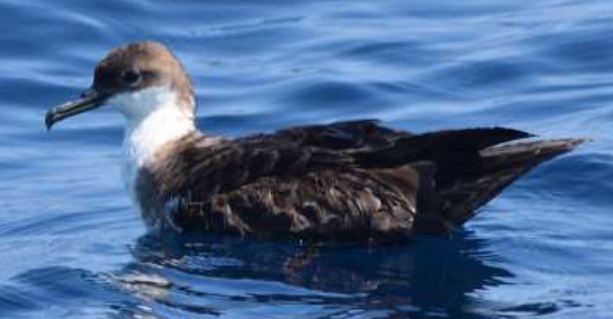
Photo by Paul E. Conover
Two (2023-048) on 9 September 2023, Gulf of Mexico: Leg began at 28°13'23.5"N 88°45'53.5"W, presumably ending at 28°11'23.9"N 88°32'55.2"W based on beginning point of next eBird list.; Paul E. Conover (ph) and David P. Muth (ph).
Three (2023-048) on 9 September 2023, Gulf of Mexico: Leg began at 28°11'23.9"N 88°32'55.2"W; Paul E. Conover (ph) and David P. Muth (ph).
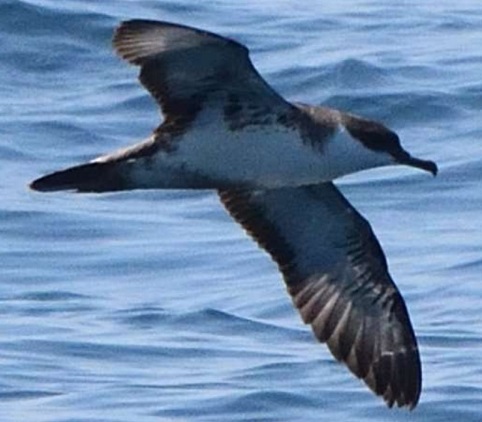
Photo by Paul E. Conover
Five (2023-049) on 9 September 2023, Gulf of Mexico: Leg began at 28°15’59.6” N 88°33’50.3” W; Paul E. Conover (ph) and David P. Muth (ph).
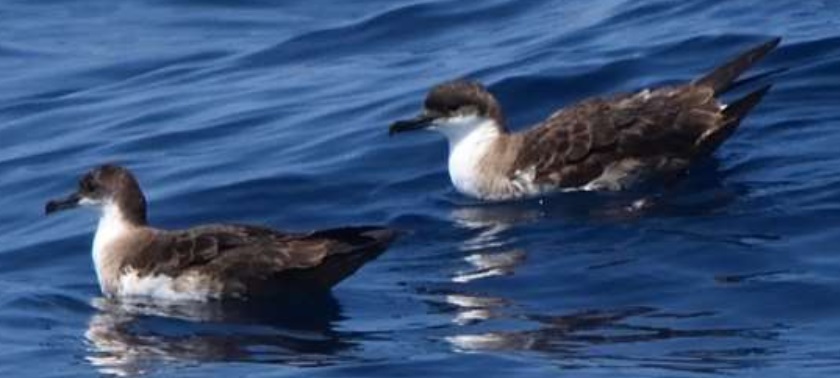
Photo by Paul E. Conover
One (1995-35) on 22 Jun 1995, Gulf of Mexico: approximately 110 mi. S of Morgan City, 28o08'10"N, 91o37'00"W. All but one member believed the description was not sufficient to rule out Cory's Shearwater, or perhaps even Black-capped Petrel (Pterodroma hasitata). Members also noted that the observer admittedly did not have any previous experience with this species.
One to three individuals (1999-091), one each on 15 August, 17 October, and 30 October 1999, Gulf of Mexico: 97 mi. S New Orleans, South Pass 89 B oil platform, N 28.68044o,W 89.38578o. It is highly unlikely that the same individual would have been involved in all three sightings, and the three observations probably should have been submitted as separate reports. The best description was from the 15 August sighting, but Members were concerned with potential confusion with Cory’s or Cape Verde shearwaters, which were not convincingly eliminated by the details. It was also recognized that this report pre-dated the first hard evidence occurrence, and this also contributed to some Members’ reluctance to accept. Ultimately, the report was not accepted following a Discussion Vote.
One (2012-141) on 30 August 2012, St. Tammany: Lake Pontchartrain from the Lake Pontchartrain Causeway. Most Members were unconvinced that the brevity of the observation and naked-eye views were sufficient to be certain of what would have been the first non-pelagic occurrence of this species.
One (2018-058) on 25 August 2018, Gulf of Mexico: Carnival Breeze Cruise 8/25/18 Leg 13/30, off Plaquemines Parish, Louisiana, US Start: N26.663o, W89. 711o (heading Northwest towards Galveston). All Members agreed that the brief, distant observation, resulting brief description of a bird on the water, and failure to convincingly eliminate other superficially similar species such as Cory’s Shearwater and Pomarine Jaeger did not warrant acceptance.